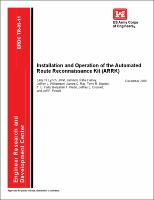Please use this identifier to cite or link to this item:
https://hdl.handle.net/11681/8502| Title: | Installation and operation of the Automated Route Reconnaissance Kit (ARRK) |
| Authors: | Information Technology Laboratory (U.S.) Lynch, Larry N. Jackson, Jill M. Fairley, Sandra K. Williamson, Jeff L. Ray, James C. Stanton, Terry R. Falls, T. C. Webb, Benjamin T. Crockett, Jeffrey L. Powell, Jeff F. |
| Keywords: | Analysis Bridge Ferry Ford Reconnaissance Road Tunnel Route TeleEngineering |
| Publisher: | Geotechnical and Structures Laboratory (U.S.) Engineer Research and Development Center (U.S.) |
| Series/Report no.: | ERDC TR ; 05-11. |
| Description: | Technical report Abstract: The TeleEngineering Operations Center at the U.S. Army Engineer Research and Development Center has developed an initial capability to automate route reconnaissance. The Automated Route Reconnaissance Kit (ARRK) was developed to allow route information such as radius of curvature and slope to be determined as a vehicle is driving along the route. Other capabilities such as identifying obstacles and marking the location of bridges, ford sites, ferry sites, and tunnels are included in the ARRK. The ARRK software uses the collected data to produce a standardized route reconnaissance form that can be used for planning or executing missions. The purpose of this report is to describe the components of the ARRK and to provide step-by-step procedures required to set up and operate the system and to process the collected data. Chapter 2 describes the components of the system. Chapter 3 provides details on installation of the equipment in a ground vehicle and the interconnections among the individual components. The setup and operation of the data collection and processing software is presented in Chapter 4. Chapters 5 and 6 explain how to collect and view the reconnaissance data. Adding the recon data to a route database is discussed in Chapters 7 and 8. Procedures to add additional data to the route database and create a final product are described in Chapters 9 and 10; methods of receiving technical support are provided in Chapter 11. Appendix A provides quick-start instructions for the system; Appendix B provides the bridge reconnaissance requirements. |
| Rights: | Approved for public release; distribution is unlimited. |
| URI: | http://hdl.handle.net/11681/8502 |
| Appears in Collections: | Technical Report |
